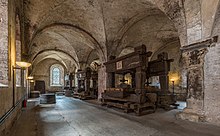
German wine is primarily produced in the west of Germany, along the river Rhine and its tributaries, with the oldest plantations going back to the Roman era. Approximately 60 percent of German wine is produced in the state of Rhineland-Palatinate, where 6 of the 13 regions (Anbaugebiete) for quality wine are situated. Germany has about 103,000 hectares of vineyard, which is around one tenth of the vineyard surface in Spain, France or Italy. The total wine production is usually around 10 million hectoliters annually, corresponding to 1.3 billion bottles, which places Germany as the eighth-largest wine-producing country in the world. White wine accounts for almost two thirds of the total production.

The German wine classification system puts a strong emphasis on standardization and factual completeness, and was first implemented by the German Wine Law of 1971. Nearly all of Germany's vineyards are delineated and registered as one of approximately 2,600 Einzellagen, and the produce from any vineyard can be used to make German wine at any quality level, as long as the must weight of the grapes reaches the designated minimum level. As the current German system does not classify vineyards by quality, the measure of wine ’quality’ is the ripeness of the grapes alone.

Maulbronn Monastery is a former Cistercian abbey and ecclesiastical state in the Holy Roman Empire located at Maulbronn, Baden-Württemberg. The monastery complex, one of the best-preserved in Europe, was named a UNESCO World Heritage Site in 1993.

Assmannshausen is, since its incorporation in 1977, a quarter of Rüdesheim am Rhein in the Rheingau, located on the Rhine in the state of Hesse, Germany. The village has a lithium spring, spa and a Kurhaus, and is famed for its red wine (Assmannshäuser) made from Pinot noir, which resembles red Burgundy wine. The Hessische Staatsweingüter Kloster Eberbach are running their VDP red wine estate in the village.

Eltville am Rhein is a town in the Rheingau-Taunus-Kreis in the Regierungsbezirk of Darmstadt in Hesse, Germany. It lies on the German Timber-Frame Road.

The Abbey of Fontenay is a former Cistercian abbey located in the commune of Marmagne, near Montbard, in the département of Côte-d'Or in France. It was founded by Saint Bernard of Clairvaux in 1118, and built in the Romanesque style. It is one of the oldest and most complete Cistercian abbeys in Europe, and became a UNESCO World Heritage Site in 1981. Of the original complex comprising church, dormitory, cloister, chapter house, caldarium, refectory, dovecote and forge, all remain intact except the refectory and are well maintained. The Abbey of Fontenay, along with other Cistercian abbeys, forms a connecting link between Romanesque and Gothic architecture.
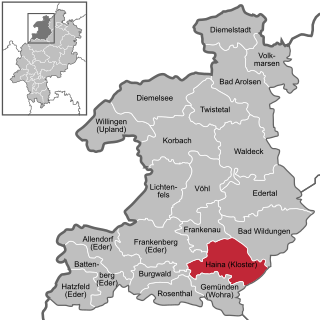
Haina (Kloster) is a municipality in Waldeck-Frankenberg in northwest Hesse, Germany.
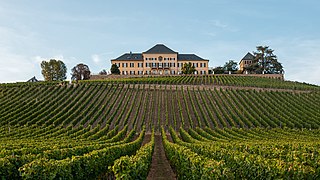
Schloss Johannisberg is a castle and winery in the village of Johannisberg to the west of Wiesbaden, Hesse, in the Rheingau wine-growing region of Germany. It has been making wine for over 900 years. The winery is most noted for its claim to have "discovered" late harvest wine. The palace is a venue of the Rheingau Musik Festival, made available by co-founder Tatiana von Metternich-Winneburg.
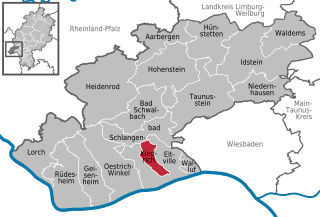
Kiedrich is a municipality in the Rheingau-Taunus-Kreis in the Regierungsbezirk of Darmstadt in Hesse, Germany.

Bebenhausen Abbey is a former Cistercian monastery complex located in Bebenhausen, Baden-Württemberg, Germany. The complex is also the location of Bebenhausen Palace, a hunting retreat created and maintained by two Kings of Württemberg. The complex was named a historic monument in 1974.

Verband Deutscher Prädikatsweingüter e.V. or the Association of German Prädikat Wine Estates, is an association of more than 200 wineries in Germany that promotes binding quality standards and – since 1990 – also ecological management of its members' wineries. Many of Germany's top wine producers are members. It is commonly known by its abbreviation VDP.
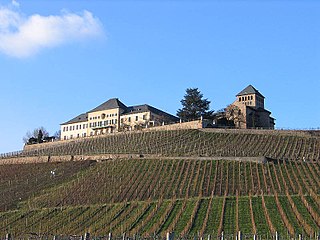
Rheingau is one of 13 designated German wine regions (Weinbaugebiete) producing quality wines . It was named after the traditional region of Rheingau, the wine region is situated in the state of Hesse, where it constitutes part of the Rheingau-Taunus-Kreis administrative district. Although, making up only 3 percent of the total German vineyard area, Rheingau has been the source of many historically important innovations in German wine making, and contains many wine producers of international reputation, such as Schloss Johannisberg. Rheingau, with 3,125 hectares of vineyards in 2016, also boasts a higher proportion of Riesling (77.7%) than any other German wine-growing region, with Spätburgunder making up most of the rest (12.2%), followed by Müller-Thurgau.

A number of German wine auctions are held each year, where the premier German wine producers auction off some of the best young wines, as well as some older wines. Most auctions are arranged by the regional associations of Verband Deutscher Prädikatsweingüter (VDP). These auctions differ from wine auctions on the second-hand market held by auction houses, where collectible wines are sold by private or corporate owners, since it is "first hand" wines that are sold.

The Hessische Bergstraße is a defined region (Anbaugebiet) for wine in Germany located in the state of Hesse among the northern and western slopes of the Odenwald mountain chain. With only 467 hectares of vineyards it is the smallest of the 13 German quality wine regions. At 21% red grape varieties and 79% white varieties, it is planted with primarily Riesling, Pinot gris (12%) and Spätburgunder. Hessische Bergstraße is divided into two districts (Bereiche) – Umstadt and Starkenburg – three collective vineyard sites and 24 individual vineyard sites.

Valmagne Abbey is a former Benedictine monastery located near Villeveyrac, Hérault, in south-central France. It is a designated historic monument.

Hattenheim is a Stadtteil in Eltville am Rhein, Hesse, Germany. It lies within the Rheingau wine region.

Steinberg is a 32.4 hectares wall-enclosed vineyard near Hattenheim in the Rheingau. It is the largest wall-enclosed vineyard in Germany.

Erbach is a Stadtteil in Eltville am Rhein, Hesse, Germany. It lies within the Rheingau wine region.
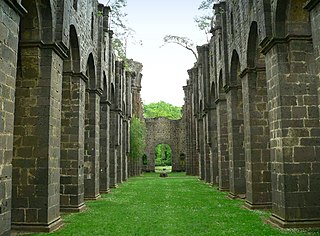
Arnsburg Abbey is a former Cistercian monastery near Lich in the Wetterau, Hesse, Germany. It was founded by monks from Eberbach Abbey in 1174. Although heavily damaged in the Thirty Years' War it was rebuilt later in the 17th century and prospered in the 18th century, when much of the abbey was rebuilt in Baroque style.

Nothgottes is a Cistercian monastery and a pilgrimage destination above Eibingen, in Rüdesheim am Rhein, Hesse, Germany. Pilgrimages to the location date back to the 14th century, and have continued to the present day, especially an annual pilgrimage from Kruft that began in 1674.




